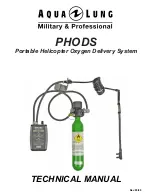
Simrad PI44
274
850-165085 / Rev.B
(3) = None, one, two or three short flashes: The
number of short flashes signifies the first digit of the
configured channel number.
(4) = A second start flash: This signals that the second
digit of the channel number is next.
(5) = None to nine short flashes: The number of short
flashes signifies the second digit of the configured
channel number.
3
Using a multimeter, check the DC current between the
negative charging lug (A) and the water detector (B).
- With the initial sea water switch and a a fully charged
battery, the current should not exceed 150
µ
A.
- With a redesigned sea water switch (sacrificial bolt)
and a a fully charged battery, the current should not
exceed 67
µ
A.
- If you measure 0
µ
A, check the fuse on your
multimeter.
Testing on land
1
Connect the PI Service Hydrophone to the PI Operator
Unit.
2
Place the sensor on a level surface with its “domed top”
pointing towards the test hydrophone approximately five
meters away.
3
Use the
Status display
on the PI to monitor the sensor’s
signal strength.
- If the interference filter is on, the spectrum displayed
should be relatively flat (approximately 25 dB,
interference filter set at level 9) with a peak detected in
the configured channel.
4
Check that the Catch symbol on the PI is activated (red
symbol and audible alarm) when one of the detector wire
is pulled out.
5
Release the detector wire, and check that the sensor
presentation changes to yellow.
Testing in water
1
Disconnect the PI Service hydrophone, and reconnect the
vessel’s normal hull mounted hydrophone.
2
Switch off the vessel’s echo sounders, sonars and other
hydroacoustical equipment to avoid interference.
3
Lower the sensor over the side of the vessel.
Содержание PI44 C
Страница 2: ......
Страница 265: ...PI Configurator 253 850 165085 Rev B Quit Click this button to close the PI Configurator utility...
Страница 320: ......
Страница 321: ...hjk...
Страница 322: ...E 2005 Simrad AS ISBN 82 8066 046 1...
















































